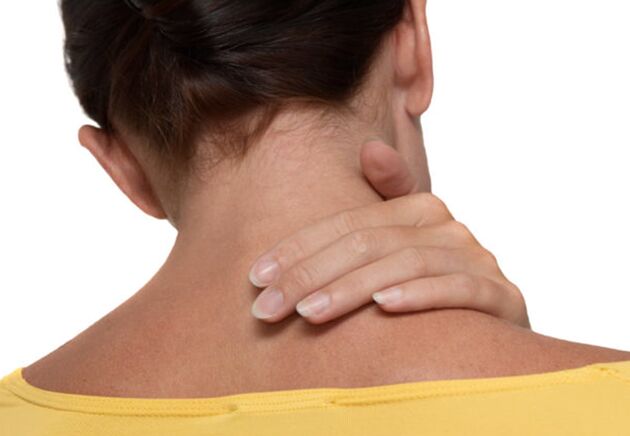The upper limbs are periodically numb and is the mobility of the tongue disturbed?Are you worried about headache and weakness?Is the pressure sharp or falls, is the heart rhythm lost or quickly?Symptoms indicate trapped nerves and problems with the spine.The most likely cause is cervical osteochondrosis, which is accompanied by muscle spasms and dizziness.The disease, unlike myths, appears in young people and requires good treatment.

Factors and precautions
Provocation cervical osteochondrosis is capable of:
- bad metabolism;
- sitting or sitting lifestyle;
- Microcirculation disorder, a hereditary disease;
- Injuries of the neck or shoulder department.
Patients who suspected signs of osteochondrosis first consult a doctor and go through CT or MRI.In addition, take blood tests to understand what exactly the development of the disease has provoked.
The treatment is selected separately, depending on the cause.The doctor gives a direction for massage or prescribes tablets, ointments or gels with an anti -inflammatory effect.Sometimes spasms and pain disappear when you buy an orthopedic pillow or change work.
Nobody is safe against cervical osteochondrosis, but they are in danger:
- office workers;
- Sellers;
- medical staff;
- Teachers and teachers;
- managers;
- Hairdressers;
- Programmers.
Representatives of these professions are a lot or sit on the computer, but the cervical and shoulder departments remain inactive.The muscles are weakened, cartilage loses elasticity and intervertebral discs receive a minimum of nutrients.The risk of squeezing the nerve endings and osteochondrosis is increasing.
Do you really have to look for a new job?No, if the patient:
- Replace the usual mattress and the down pillow with orthopedic varieties;
- selects a handy computer chair with a high back;
- will regularly go home or in the gym, muscles and joints;
- refuse nicotine and alcohol;
- View the usual diet and make some changes.
Women are recommended to leave high heels and to love ballet shoes or sneakers.
Osteochondrosis does not disappear immediately after purchasing the right cushion or two or three classes in the gym, but gradually the well -being will improve and the symptoms will disappear with the disease itself.
More vegetables and proteins
The recovery is promoted by the right nutrition.Patients with an excess body weight are recommended to gradually lose weight to reduce the load on the joints and intervertebral discs.But starving is forbidden, as well as sitting on mono -tabs.

A person with osteochondrosis must receive a sufficient amount of calcium and magnesium daily, as well as phosphorus and potassium.The recovery of nerve endings is facilitated by B vitamins that remove inflammation, and ascorbic acid needed for the production of collagen.You can't do it without proteins in meat and eggs.
The condition of the cervical vertebrae worsens by salt, fried food and animal fats.We will have to forget the existence of the pan and love steam dishes, replace the butter with vegetable oil and buy chicken fillet instead of sausage.
Marinades and white bread, canned food, sweet drinks and semolina lead to worsening of osteochondrosis.Inflammation and pain in the cervical area will remove:
- Parsley, who compacts blood;
- Sea fishing and salads with linse oil;
- walnuts and liver;
- legumes, in which there are many vitamins of group B and protein;
- chicken or beef meat;
- Honey;
- steamed vegetables and fresh or fried fruit;
- Disleld with gelatin;
- Cooked beef names that perform the function of chondroprotectors.
Metabolic processes normalize grains and dairy products, herb cooking and ordinary water.The dehydrated organism is restored slower and soft and bone tissues with a lack of liquids become vulnerable.
Coffee and black tea are contrary to osteochondrosis, which have a diuretic effect and contribute to losing calcium and other useful minerals from the body.
Day starts with charging
Exercises are contraindicated in worsening the disease.It is recommended to participate after drugs or alternative treatment when pain and inflammation disappear.A special complex will restore the mobility of the cervical and shoulder area, relieve muscle spasms and dizziness.

Start with simple exercises, so that the task gradually complicates:
- Lie down on a couch or couch and hang your neck and head.The surface must be straight, without lumps and pits, moderately stiff.The shoulders are on the couch, the hands are relaxed and extensively past the body.Try to only tension the muscles of the neck, lift it smoothly and lower it.10 repetitions.Turn to the right and then on the left.
- Sit on a chair or get in the middle of a room with a straight back.To relax the muscles of the neck and shoulders, allowing the head to fall forward and left, back and right.Tilt 4-6 in each direction.Then look for the muscles of the neck as much as possible and make similar movements, try to get the chin on the chest and touch the shoulders with his cheeks.
- Stay in a sitting position with a right back, take a pencil or pen in the teeth.Only move the head and neck, move letters or numbers in the air and try not to repeat themselves.
- Put on with a pencil, turn to the right and look over the shoulder.Try to press the palm on the cheek or temple and try to return to the starting position.The head tries to overcome pressure and makes pine -shaped movements that fragment the muscles of the neck and the thoracic area.30 - 40 repetitions and then turn the other direction.
- Lie a belly on the floor and stretch your hands along the body.Stick your forehead in the ground and stretch the upper limbs above your head, without bending your elbows.Stay hanging for 4-6 seconds, take the starting position.
Exercises 1, 3 and 4 can be done with weighing agents.Suitable small dumbbells that weigh no more than 0.5 kg, or half -letters water.Apply them to the head, hold their hands and make curves and tendencies.
The muscles are recommended to knead in the morning to wake the body, and in the evening, as well as during a lunch break.
Folk methods for combating osteochondrosis
Non -traditional methods for the treatment of the cervical region are necessarily discussed with a doctor.Some homeopathic medicines and procedures worsen the patient's condition and lead to aggravation of osteochondrosis.

Lilac
Fill a liter pot with fresh purple flowers.Compact no raw materials, pour alcohol mixed with water or vodka.Stay under the bed for 2 weeks, shake periodically.The product was rubbing in the neck and shoulders, and use 30-40 drops inside.Add to water or tea, drink after dinner.
Compress and radish
Inflammation is removed mud masks.The component for applications can be ordered in specialized stores.Keep the dirt in a glass container, a bay of the words.Harvesting for the compress is heated to 40 degrees in a water bath and applied to the neck, on the left until it is cool.You need 10 to 15 regular procedures.
Instead of dirt, freshly squeezed juice from radish is used, which is mixed with an equal amount of honey.Get it that a mixture of a day and then dilute with vodka.For part of alcohol, 4 parts of the juice.Rub in the inflamed area with massage movements, cover with plastic film and wrap with a scarf.Depart for a few hours or go to bed with a honey compresses and rinse the remains in the morning.
Warm lotions
Dip the cabbage leaf 30-40 seconds in boiling water.Remove and beat quickly with a hammer until it has cooled.Small a thin layer of honey, attach to the neck.Fix with a household film, wrap it with a scarf or scarf.Wait 1 hour.
Horseradish leaves are used instead of cabbage.The workpiece is immersed in boiling water, but not treated with honey.They wrap the neck with warm leaves and covered with a scarf on top.
Fixed rye tortillas, as well as a mixture of grated cooked potatoes and honey, are applied to the neck.The mass is wrapped in mesh so that it does not spread over the body and waits for 20 minutes.
After compresses or lotions, an analgesic ointment is rubbed into the muscles.
Spasms are taken with spasms.The tablets relaxed smooth muscles, but lower blood pressure.
Self -massage
When applying a gel or ointment you must knead the neck and shoulders.Carefully press, squeeze, rub and stroke it into a slight redness of the skin.Spiral and circular movements, as well as vibrations, removal discomfort sensations.
Series fans are recommended to spend time with the advantage of the back and neck:
- To wet a towel or piece of cotton tissue in saline solution.
- Do not rinse, dry on the battery so that the workpiece becomes stiff.
- Sitting on the couch, wind the ends of the towel in the palm of your hand and throw behind us.
- Pull, rub the skin and muscles with "saw" movements until a light tingling appear.
- Finish the massage with the very towel beating.
It is impossible to press hard on the spine, because the main task of massage is to improve blood circulation in the neck.The procedure is repeated daily, you can get applicants, which are made especially for the treatment of osteochondrosis.
The rejection of bad habits and regular exercises will stop the destruction of the intervertebral discs.Diet in combination with medicines and homeopathic remedies will remove inflammation and restore cartilage tissue.It is not difficult to get rid of osteochondrosis if you follow the advice of specialists and take care of your own body every day.




























































































